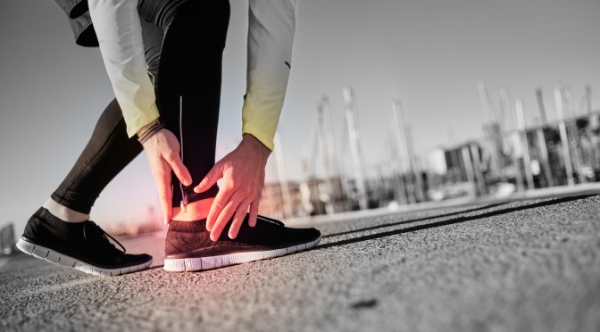Connect With Us
Blogs

Health Tips (46)
Strengthening Weak Ankles for Walking, Hiking or Running
A firm foundation is more important than many people may even realize. Working together as a powerful team, the foot and the ankle provide balance, support and mobility to the body, helping to form a strong base and keeping it on the go. When an instrumental component to this structure becomes weakened, it can put limitations on a person’s involvement in the activities that they love. Weak ankles are a prime example of this, and for men and women alike, it can be the main factor that prevents them from joining in on a fun game of soccer, going on a hike or a run, or merely accomplishing the tasks of day to day life with a normal degree of comfort and stability.
Causes & Symptoms
Oftentimes, a person’s ankles can become unstable as a result of previous injuries, congenital causes or repeated ankle sprains. A common feeling is an unsteadiness or a giving out of the joint. It is also fairly typical for individuals with weak ankles to favor the lateral part of their feet, leaving the legs and feet feeling tired or exhausted by the end of the day. The situation can worsen by rolling the ankle, which can cause swelling, tenderness and pain.
Ways to Strengthen Your Step
It can be said that weak ankles are a part of a vicious cycle. Commonly caused by injury, they then subsequently increase the risk for further missteps, injuries, or sprains. Like many other foot issues, discovering the best method of treatment is most suitably done after a podiatrist examines the foot and determines the exact source of the problem. However, in general, performing these basic stretches and exercises every other day can help to strengthen the ankle-supporting muscles that have been weakened, and promote stability, flexibility and future sprain prevention:
Balancing Stance – Stand on one foot and balance yourself. This works the supporting muscles of the ankle as it shifts to remain stable during the pose. Then switch feet and repeat the exercise. You can also try this while holding hand weights to further build up the muscles.
Heel Raises & Walks – Stand with feet shoulder width apart and slowly lift yourself up on your toes. Hold briefly and then lower the heels down to the starting position. Do this for 10-15 reps. If you find this too difficult, hold onto the back of a chair for support. To increase the challenge and muscle strengthening, try the exercise while holding weights. Another muscle strengthening exercise is to balance yourself on your heels and walk around the room.
Resistance Exercises – At Superior Foot & Ankle Care Center, we offer Thera-Band products such as resistance bands to help patients improve range of motion and muscle cooperation. These bands can be used to strengthen weak ankles through simple exercises. For example, in one exercise, sit on the floor and wrap an end of the band around the foot. Grab the other end with both hands and push your foot forward. Then return to the original position. Do this for about 15 to 20 reps. You can also try tying the band to a stable fixture. Once seated, wrap the other end around your foot. Then flex the toes inwards against the band.
Keeping Your Feet Healthy & Your Ankles Strong
For hikers, runners and athletes, keeping ankles strong is extremely necessary to maintain their performance and level of activity. But overall, weak ankles can have an impact on those of any pursuit, coming in between doing the things they enjoy and making further injury a bigger risk. If you have concerns about your ankle pain or another foot problem, request an appointment at Superior Foot & Ankle Care Center in Long Beach today. We provide the highest standard of care to treat each patient with their individual symptoms and needs. Viewing surgery as a last resort, we put our podiatry knowledge to good use, so our patients can put their best foot forward through life.
Often times, the importance of keeping feet healthy can get kicked under the rug and then easily forgotten. However, whether you’re going out for a run, shooting some hoops, or getting involved and supporting the Special Olympics, the value of proper foot care comes swiftly into play. While treatment from a Long Beach foot doctor is an appropriate way to ensure your individual needs get met, there are some general steps you can take to leading an active lifestyle with happy, healthier feet.
Lending a Helping Hand to Treat Feet
In the spirit of inclusion, involvement, and fun, thousands of people will come together for the 2015 Special Olympics World Games. With the help of students, residents, and other podiatrists, Dr. Foley of Superior Foot & Ankle Care Center will serve her cause by performing foot screenings on the 7,000 participating athletes from 177 countries. The goal of this service is to ensure each competitor has appropriate shoes and gets foot care advice, in the hopes of keeping their feet and the games going strong.
Foot Screenings Will Focus on These Feet Factors:
- Proper footwear
- Toenail fungus
- Athlete’s foot
How to Handle After-Exercise Foot Pain
Athletes are commonly more afflicted by foot pain, as they rely on their feet to perform. Athlete or not, everyone can use a helping hand in dealing with this discomfort. Try following these 3 helpful tips, the next time you encounter foot pain after intense physical activities:
- Rest & Foot Elevation – While it may not be easy to tell an athlete or heavily active person to give it a rest, that’s just what might be necessary to find a little foot pain relief. Also, as you are in a relaxed position, elevate your feet above the waist to reduce the foot pain and reduce possible swelling.
- Ice – Applying ice is another way to alleviate foot discomfort, decrease inflammation, and numb the aches. This can work to relieve heel pain from a strained plantar fascia, but may be inadvisable for those with diabetes or circulation issues.
- Listen to Your Body – Just like in other areas of the body, if pain persists, your feet are possibly trying to get your attention. Forget the no pain, no gain adage and visit your Long Beach foot doctor. Regular foot check-ups and preventative care measures will help keep healthy feet strong and foot pain at bay.
Consult a Long Beach Podiatrist for Foot Pain Relief
No matter if you are involved in the Special Olympics or not, foot discomfort certainly has a way of getting in the way of exercise and day-to-day activities. The experienced doctors and staff at Superior Foot & Ankle Care Center are dedicated to helping out in the community and helping people everywhere have happy and healthy feet through quality treatment. Feel free to contact our office to schedule an appointment for foot pain relief.
It is no surprise that at Superior Foot & Ankle Care Center we care about feet, but another health concern we hold close to our hearts is heart disease. That is why our team took their feet to the pavement and eagerly participated in the 2015 Orange County Heart and Stroke Walk. This event strove to raise money and awareness for the severity of cardiovascular disease for medical research and for methods of prevention.
You aren’t alone if you didn’t realize the seriousness of this condition, but here are some important facts about heart disease that reveal exactly how concerning it can be.
Facing the Facts about Heart Disease
According to the American Heart Association:
- Heart Disease is the leading cause of death
- Over 375,000 U.S. citizens die from heart disease
- No. 1 cause of death in women
- Every 43 seconds, someone in America is affected by heart disease
- About 635,000 people a year have their first heart attack
Prevention Intervention
These statistics are no doubt alarming to say the least. So, what are a few steps you can take to help prevent heart disease?
Whether you are taking part in a Heart Walk or playing soccer or working out at the gym, physical activity is one important factor in reducing the risk of this disease. Exercising 30 minutes or more a day can manage your body weight and help eliminate conditions such as high cholesterol and high blood pressure that put stress on the heart.
Hand in hand with exercise, is the factor of maintaining a healthy diet. Heart healthy foods like beans, grains, fruits and vegetables are excellent choices. However, foods that are deep-fried or loaded with trans and saturated fats are unnatural and unhealthy. They can increase your cholesterol as well as your chances for a heart attack. Eliminating these food choices from your diet and other health-risks like tobacco, are great ways to prevent heart disease.
Healthy Heart & Happy Feet
These were just a few steps to take to keep your heart healthy. If those steps have literally left you with foot issues or if you are interested in participating in a Heart Walk with us in the future, please contact our foot and ankle care center. We are eager to help you follow the road to better health.
Diabetes and Your Feet – 5 Daily Activities for Standing on Your own two Feet
dev- Check Your Feet Everyday—During middle of the day, after work, or anytime you come home after being out, check soles for cuts, scratches, blisters, etc. If you can’t see the bottoms of your feet for some reason, then ask for assistance, or use a mirror. Don’t just ignore this daily task.
- Wear Socks and Shoes—Think of socks and shoes like you do the seatbelt in your car. Don’t head out until you know that everything is secure and where it should be. A sock that falls, rubs, or irritates can go unnoticed and end up causing you pain or a trip to the doctor.
- When Wearing Socks and Shoes Choose Comfort—It’s a fact that fashion and function don’t always go together, but when dealing with diabetes, you need to go with what’s comfortable. Don’t wear socks that are too tight, or shoes that cause discomfort.
- Keep Your Feet Squeaky Clean—Take the time to wash your feet every day. This means scheduling time for some foot maintenance beginning with washing. While you’re at it, however, you may as well take the time to trim your nails, carefully smooth rough patches, and whatever else you may be facing.
- Don’t Go Around Barefoot—The National Diabetes Education Program recommends always wearing something on your feet to protect them from hot and cold surfaces as well as potentially stepping on something sharp.
As a diabetic, you’re probably well aware of having the number of a good doctor on hand. Take the extra step and make sure you have a good podiatrist in mind as well. No matter how well you take care of your body, nothing can replace the care of a medical expert.


